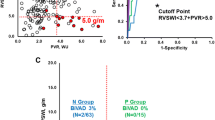Abstract
How to manage preoperative right ventricular dysfunction (RVD) in heart failure patients without cardiogenic shock remains as a matter to be debated because implantable biventricular assist device treatment has not been established thus far. We here presented a patient with significant RVD indicated by low RV stroke work index (0.3 g/m) and RV dilatation as well as low pulmonary vascular resistance (PVR, 0.8 Wood Unit), who was managed by the introduction of pimobendan and sildenafil after the implantation of DuraHeart and tricuspid annuloplasty without right VAD, although his New York Heart Association symptom remained class III. Preoperative low PVR may be a key for successful LVAD treatment alone without right VAD in patients with INTERMACS profile 3 suffering RVD.



Similar content being viewed by others
References
Kirklin JK, Naftel DC, Pagani FD, et al. Sixth INTERMACS annual report: a 10,000-patient database. J Heart Lung Transplant. 2014;33:555–64.
Kinugawa K. How to treat stage D heart failure?—When to implant left ventricular assist devices in the era of continuous flow pumps? Circ J. 2011;75:2038–45.
Imamura T, Kinugawa K, Hatano M, et al. Low cardiac output stimulates vasopressin release in patients with stage d heart failure. Circ J. 2014;78:2259–67.
Slaughter MS, Rogers JG, Milano CA, et al. Advanced heart failure treated with continuous-flow left ventricular assist device. N Engl J Med. 2009;361:2241–51.
Rose EA, Gelijns AC, Moskowitz AJ, et al. Long-term use of a left ventricular assist device for end-stage heart failure. N Engl J Med. 2001;345:1435–43.
Shiga T, Kinugawa K, Imamura T, et al. Combination evaluation of preoperative risk indices predicts requirement of biventricular assist device. Circ J. 2012;76:2785–91.
Cleveland JC Jr, Naftel DC, Reece TB, et al. Survival after biventricular assist device implantation: an analysis of the interagency registry for mechanically assisted circulatory support database. J Heart Lung Transplant. 2011;30(8):862–9.
Ochiai Y, McCarthy PM, Smedira NG, et al. Predictors of severe right ventricular failure after implantable left ventricular assist device insertion: analysis of 245 patients. Circulation. 2002;106:I198–202.
Fukamachi K, McCarthy PM, Smedira NG, Vargo RL, Starling RC, Young JB. Preoperative risk factors for right ventricular failure after implantable left ventricular assist device insertion. Ann Thorac Surg. 1999;68:2181–4.
Fitzpatrick JR 3rd, Frederick JR, Hsu VM, et al. Risk score derived from pre-operative data analysis predicts the need for biventricular mechanical circulatory support. J Heart Lung Transplant. 2008;27:1286–92.
Santambrogio L, Bianchi T, Fuardo M, et al. Right ventricular failure after left ventricular assist device insertion: preoperative risk factors. Interact Cardiovasc Thorac Surg. 2006;5:379–82.
Matthews JC, Koelling TM, Pagani FD, Aaronson KD. The right ventricular failure risk score a pre-operative tool for assessing the risk of right ventricular failure in left ventricular assist device candidates. J Am Coll Cardiol. 2008;51:2163–72.
Kormos RL, Teuteberg JJ, Pagani FD, et al. Right ventricular failure in patients with the HeartMate II continuous-flow left ventricular assist device: incidence, risk factors, and effect on outcomes. J Thorac Cardiovasc Surg. 2010;139:1316–24.
Imamura T, Kinugawa K, Hatano M, et al. Bosentan improved persistent pulmonary hypertension in a case after implantation of a left ventricular assist device. J Artif Organs Off J Japanese Soc Artif Organs. 2013;16:101–4.
Imamura T, Kinugawa K, Kato N, et al. Late-onset right ventricular failure in patients with preoperative small left ventricle after implantation of continuous flow left ventricular assist device. Circ J. 2014;78:625–33.
Conflict of interest
The authors declare that they have no conflict of interest.
Author information
Authors and Affiliations
Corresponding authors
Rights and permissions
About this article
Cite this article
Imamura, T., Kinugawa, K., Nitta, D. et al. Biventricular failure with low pulmonary vascular resistance was managed by left ventricular assist device alone without right-sided mechanical support. J Artif Organs 18, 272–275 (2015). https://doi.org/10.1007/s10047-015-0829-x
Received:
Accepted:
Published:
Issue Date:
DOI: https://doi.org/10.1007/s10047-015-0829-x




